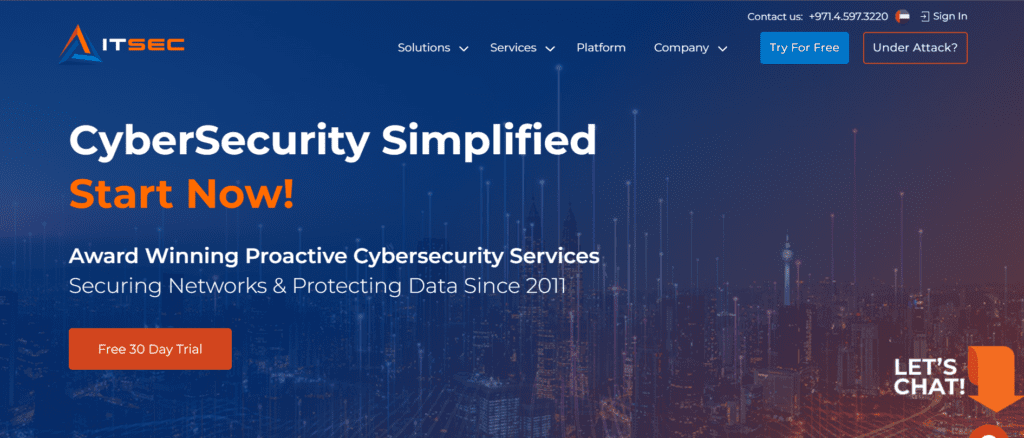1. Verify the authenticity of the certification AuthenticityBegin the verification process by confirming whether the business has received the appropriate certifications. Contact the issuing authority or the certification body to confirm that the certifications are legitimate and current. Alongside other certifications, ISO 27001 PCI DSS copyright are just a few to think about. Valid certifications demonstrate conformity to security standards.
2. Understanding Local Regulatory Compliance
Find out about local laws governing cybersecurity, such as the UAE Data Protection Law. Also, be familiar with in the Dubai Cybersecurity Strategy. Assuring that your business adheres to the legal frameworks could be a cause of legal penalties or reputational damage.
3. Examine Industry-specific Standards
Depending on what industry you work in, specific standards might be more relevant. Healthcare organizations, for example could be required to follow HIPAA while financial institutions are urged by PCI DSS. The company can show it is equipped with the expertise required to handle specific threats to the sector through the evaluation of industry-specific certifications.
4. Demand Documentation
It is recommended to request detailed documentation that demonstrates compliance with the relevant standards. This includes audit reports, security policies as well risk management frameworks. The documentation of the company can reveal the commitment to compliance and how effective they keep up with their cybersecurity procedures.
5. Contact us to learn more about audits by third parties
If your company is subject to periodic audits from third parties it is important to determine. Independent audits offer a more independent evaluation of the compliance and security practices of a business. Audit reports from trusted firms that verify the practices of the business are crucial.
6. Evaluate Continuous Improvement Initiatives
The world of cybersecurity is changing and companies must demonstrate they're committed to continual improvement. It is possible to determine whether your company is regularly updating their policies and technologies to be able to adjust to changes in regulations and new threats. This could mean changing their security policies and receiving ongoing training.
7. Consider the Employee Training Programs
Training employees is vital to a solid cybersecurity posture. Ask about training courses that the business offers in compliance and cybersecurity. Regular training will ensure that employees are informed of most recent threats.
8. Review Incident Response Plans
Know the company's procedure for handling incidents. A well-constructed incident response plan will detail the company's notification procedure, remediation plans as well as other elements. Make sure that the procedures are in line with best practices and compliance requirements.
9. Get client testimonials References, reviews and testimonials
Get references from current customers who can verify the certifications and compliance of the company. Testimonials can provide insights into the company's reliability and efficiency in tackling cybersecurity risks. This will help to assess their standing within the market.
10. Research Industry Recognition
Find out about the reputation of the company in the cybersecurity industry. Look for awards, certificates and membership in professional organizations that emphasize their commitment to cybersecurity excellence. Credibility and experience of a business are usually closely linked to its reputation. Follow the best Cybersecurity Company in Dubai for site info including information technology security, managed security services, cyber security ot, cyber security for beginners, it security services company, information and cyber security, network security and, cybersecurity and business, network security management, cyber security strategies and more.

Top 10 Tips For Assessing The Technology And Tools Of A Cyber Security Services Company Based In Dubai.
1. Examine Technology StackStart by examining the technology stack of the company. This includes hardware, software, and tools they utilize. A strong and diverse technology stack indicates that the company has the capacity to tackle various cybersecurity challenges. Modern technology should be in line with the best practices in the industry.
2. Assess Security Solutions Offered
Investigate the specific security solutions the company provides including firewalls and intrusion detection systems (IDS) as well as endpoint protection as well as security information and event management (SIEM) systems. Understanding the breadth of their products can help determine whether they are able to meet your company's security needs.
3. Examine Integration Capabilities
How well do the tools and technology of the company integrate with their current systems? Seamless integration is crucial for ensuring comprehensive security coverage and minimising interruptions. Learn more about the approach they use for integrating new technologies with your existing infrastructure.
4. Contact Us to Find Out More about Automation and Artificial Intelligence
Analyze the extent to what the business is using automation and artificial (AI) intelligence in their cybersecurity processes. Automation can improve effectiveness and speed of response as well as AI can help in the analysis and detection of threats and can provide proactive security measures.
5. Keep an eye out for regular updates
Examine how the company updates its software as well as patches their tools. Updates are crucial to safeguard yourself from the latest threats and vulnerabilities. Regular maintenance of tools demonstrates a commitment towards security.
6. Assessment of Vulnerability Assessment Tools for Evaluation
Take a look at the processes, tools and policies of the business regarding vulnerability management. In order to identify and fix weaknesses in your system, effective vulnerability scanning and management is critical. Find out their method of prioritizing and repairing vulnerabilities.
7. Review Incident Response Technologies
Learn about the tools employed by your business to handle incidents. Utilizing effective incident response software can reduce the damage that a security breach can cause. of security. It is possible to inquire the technology-driven incident management framework.
8. Examining Tools for Reporting & Analytics
Analyze analytical and reporting capabilities of the company's tools. A comprehensive report can provide insights into the security posture and trends in incidents and the status of compliance. It is important to ensure that analytics tools are able to support the use of data to make business decisions.
9. Cloud Security Solutions
Assess the cloud security measures of the company, given the growth in cloud computing. If you work for a company that relies heavily on cloud computing, it is important to comprehend how the company protects cloud environments and the data stored there.
Check Client Feedback on Tools
Request feedback from current clients about the tools and technology employed by your company. Testimonials or case studies that highlight the performance of specific technologies can give valuable insight into their practical applications and effectiveness in real-world scenarios. Take a look at the best penetration testing dubai for more recommendations including cyber security projects, cyber security consulting company, best cyber security company, information and cyber security, information security description, cyber security services near me, cyber security education, cyber security requirement, cyber security analyst, cyber security information and more.

Top 10 Ways To Judge The Security Awareness Training Of A Cybersecurity Firm
1. Evaluate Training ContentStart by reviewing the contents of the security awareness programs. Be sure to cover important subjects, like Phishing (social engineering) and password security compliance, and protection of data. To ensure that employees are capable of recognizing and responding to any potential threats, a thorough training program is essential.
2. Check the Customization Options
Ask if the training could be tailored to meet your organization's specific needs and the culture of your company. By tailoring training to the particular challenges and scenarios faced by employees, you can increase the quality of training and engage employees and increase retention.
3. Evaluation of training delivery methods
Think about the method of delivery for the training. The options include webinars, interactive simulations, online courses, in-person training or even workshops. You can improve the effectiveness of learning by combining various formats.
4. Interactive Elements
Check to see if there are interactive elements within the course like quizzes or simulations. Interactive training increases the learning process and engagement, which makes it simpler to apply knowledge in real-world scenarios.
5. Review Frequency and Updates
Find out how frequently the training and content will be revised. In light of the constant evolution of cyber-attacks, it is essential that employees are up to date with regularly scheduled training sessions.
6. Assess the efficiency of your programs
The way a company assesses the effectiveness of the training programs they offer is crucial. Take note of metrics, for example, the pre- and post-training assessment as well as the feedback of participants or trends in the reporting of incidents. The impact of the program can be used to evaluate its effectiveness and to identify areas to improve.
7. Check for Certification and Compliant
Check if the course includes certification at the end of the program. Credibility for employees can be enhanced by certifications and show that they've acquired the necessary knowledge. Make sure that the education you provide is in line with any applicable regulations that your company may need.
8. Find testimonials and references
Gather feedback by contacting companies that utilized the service. Testimonials can provide an insight into how the training has been accepted and the efficiency. Positive feedback is an indication of the company's reputation for delivering effective awareness training.
9. Evaluation of Post-Training Training Support
After the course, you should inquire about any help you receive. Information such as newsletters, refresher classes or access to an online knowledge base will reinforce training and help keep cybersecurity awareness in the forefront of the employees' minds.
10. Examine Engagement and Culture Building
Determine how your training program helps to establish an environment of safety in your company. Find initiatives like seminars, security newsletters, or contests that promote constant awareness. A strong security culture will encourage everyone to take a role in protecting your organization. Follow the top rated iconnect for blog tips including security solution, information security and, information security usa, cyber security job, best cyber security company, cyber cyber security, cybersecurity and business, cybersecurity and business, cyber security security, cyber security consulting company and more.
